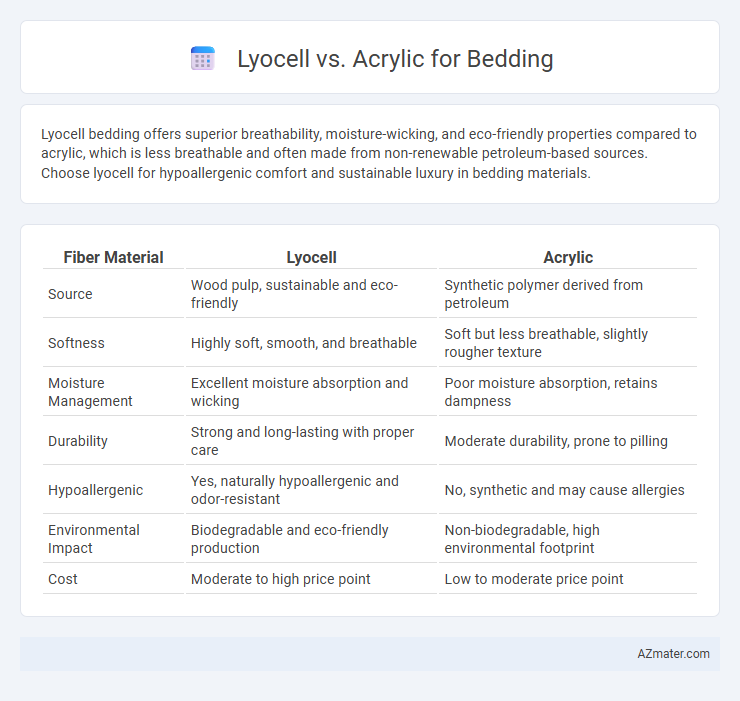Lyocell bedding offers superior breathability, moisture-wicking, and eco-friendly properties compared to acrylic, which is less breathable and often made from non-renewable petroleum-based sources. Choose lyocell for hypoallergenic comfort and sustainable luxury in bedding materials.
Table of Comparison
| Fiber Material | Lyocell | Acrylic |
|---|---|---|
| Source | Wood pulp, sustainable and eco-friendly | Synthetic polymer derived from petroleum |
| Softness | Highly soft, smooth, and breathable | Soft but less breathable, slightly rougher texture |
| Moisture Management | Excellent moisture absorption and wicking | Poor moisture absorption, retains dampness |
| Durability | Strong and long-lasting with proper care | Moderate durability, prone to pilling |
| Hypoallergenic | Yes, naturally hypoallergenic and odor-resistant | No, synthetic and may cause allergies |
| Environmental Impact | Biodegradable and eco-friendly production | Non-biodegradable, high environmental footprint |
| Cost | Moderate to high price point | Low to moderate price point |
Introduction to Lyocell and Acrylic Bedding
Lyocell bedding, made from sustainably sourced wood pulp, offers exceptional moisture-wicking and breathability, making it a preferred choice for allergy sufferers and those seeking eco-friendly bedding options. Acrylic bedding, a synthetic fiber derived from petroleum, is renowned for its warmth, durability, and resistance to wrinkles and fading, often used in affordable blankets and mattress covers. While Lyocell excels in softness and environmental sustainability, Acrylic provides cost-effective insulation and easy maintenance.
Material Origins and Manufacturing Processes
Lyocell is derived from sustainably harvested wood pulp, primarily eucalyptus, using a closed-loop process that recycles water and solvents, minimizing environmental impact. Acrylic is a synthetic fiber produced from a polymer called polyacrylonitrile, created through a chemical polymerization process involving petroleum-based raw materials. The eco-friendly production of Lyocell contrasts with the energy-intensive and non-biodegradable nature of Acrylic manufacturing, influencing their sustainability profiles in bedding applications.
Comfort and Feel: Lyocell vs Acrylic
Lyocell bedding offers exceptional softness and breathability, making it ideal for moisture-wicking and temperature regulation, which enhances overall sleep comfort. Acrylic bedding, while affordable and lightweight, tends to retain heat and may feel less smooth, often resulting in reduced breathability and less comfort over prolonged use. For a luxurious, silky feel and superior moisture management, lyocell outperforms acrylic in providing a cooler, more comfortable sleeping experience.
Breathability and Temperature Regulation
Lyocell offers superior breathability and moisture-wicking properties compared to acrylic, making it ideal for temperature regulation in bedding. Its natural cellulose fibers allow air to circulate, reducing heat buildup and keeping sleepers cool and dry throughout the night. Acrylic, being synthetic, tends to trap heat and moisture, often resulting in less effective temperature control and a warmer sleep environment.
Moisture-Wicking and Absorbency
Lyocell outperforms acrylic in moisture-wicking and absorbency due to its natural cellulose fibers that efficiently draw moisture away from the skin, promoting breathability and comfort during sleep. Acrylic, a synthetic fiber, tends to trap moisture and lacks the ability to absorb sweat, which can lead to a clammy sleeping environment. Choosing Lyocell bedding enhances dryness and temperature regulation, making it ideal for those seeking moisture control and a cool, comfortable sleep.
Durability and Longevity
Lyocell bedding offers superior durability due to its strong cellulose fibers, resisting wear and pilling over time, while maintaining softness and breathability. Acrylic bedding, although lightweight and budget-friendly, is prone to pilling and may degrade faster with frequent washing and use. Choosing Lyocell ensures longer-lasting bedding that combines resilience with eco-friendly qualities, whereas acrylic's durability tends to diminish more quickly under regular use.
Eco-Friendliness and Sustainability
Lyocell bedding is highly eco-friendly due to its biodegradable fibers sourced from sustainably managed eucalyptus forests and a closed-loop production process that recycles water and solvents, minimizing environmental impact. Acrylic bedding, derived from petroleum-based synthetic fibers, is less sustainable as it relies on non-renewable resources and contributes to microplastic pollution during washing. Choosing lyocell over acrylic supports reduced carbon footprints and promotes sustainable textile manufacturing in the bedding industry.
Allergen Resistance and Skin Friendliness
Lyocell offers superior allergen resistance due to its naturally hypoallergenic properties and moisture-wicking abilities, which reduce dust mite and mold accumulation, making it ideal for sensitive skin and allergy sufferers. Acrylic fibers, while durable and moisture-resistant, tend to attract more dust and can cause irritation for those with sensitive or allergy-prone skin. Choosing lyocell bedding enhances skin friendliness through its smooth, breathable texture, promoting a comfortable and irritation-free sleep environment.
Ease of Care and Maintenance
Lyocell bedding offers superior ease of care due to its natural moisture-wicking and antimicrobial properties, requiring less frequent washing and gentle machine cycles to maintain fabric integrity. Acrylic bedding, while wrinkle-resistant and quick-drying, is prone to pilling and static buildup, necessitating careful laundering to avoid damage and maintain softness. Choosing Lyocell reduces long-term maintenance efforts with its durability and resistance to shrinkage, compared to acrylic's synthetic fibers that demand more cautious handling.
Price Comparison and Value for Money
Lyocell bedding typically costs more upfront than acrylic due to its sustainable production and natural fiber benefits, with prices ranging from $50 to $150 per set compared to acrylic's $20 to $70 range. Despite the higher initial price, Lyocell offers superior breathability, moisture-wicking, and durability, resulting in better long-term value and comfort. Acrylic bedding tends to be more affordable but lacks the hypoallergenic and eco-friendly properties of Lyocell, making it less cost-effective for users seeking quality and sustainability.

Infographic: Lyocell vs Acrylic for Bedding
 azmater.com
azmater.com